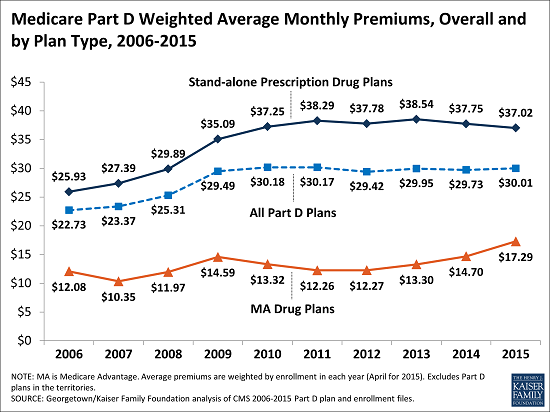
The independent source for health policy research, polling, and news.
Medicare’s Drug Benefit Is Firmly-Established After Its First Decade, With Flat Premiums in Recent Years but Higher Cost-Sharing Over Time
With Medicare Part D nearing the end of its tenth year, the program — which now provides drug coverage to 72 percent of all Medicare beneficiaries — has experienced no growth in average premiums in recent years but some notable increases in cost-sharing, according to a new report from the Kaiser Family Foundation.
At a time of heightened public concern about the cost of prescription drugs, the report, Medicare Part D at Ten Years: The 2015 Marketplace and Key Trends, 2006-2015, and a companion article in Health Affairs, examine the program’s first decade just ahead of the 2016 Medicare open enrollment period (October 15-December 7). Both papers were co-authored by Jack Hoadley of Georgetown University and Juliette Cubanski and Tricia Neuman of the Foundation. Among the key findings:
- Among Part D’s 39 million enrollees in 2015, 61 percent are in stand-alone drug plans that supplement traditional Medicare, and the rest are covered by Medicare Advantage prescription drug plans; over the past decade, the share in Medicare Advantage drug plans has increased from 28 percent to 39 percent, reflecting the overall trend in Medicare Advantage enrollment growth.
- The average monthly premium charged by stand-alone drug plans has been flat since 2010, though it has increased more than 40 percent since the start of the program, from $26 to $37. Average monthly premiums for Medicare Advantage drug plans are lower by comparison, but have been increasing since 2011.
- All stand-alone drug plans have a specialty tier, and about half of all enrollees in these plans face 33 percent coinsurance for high-cost specialty drugs. Medicare Part D stand-alone plans tend to have higher copays for brand-name and specialty tier drugs than do large employer-sponsored plans, but lower copays for generics.
- 81 percent of stand-alone Part D enrollees are now in plans with tiered pharmacy networks, a dramatic increase from 6 percent in 2011. Under such arrangements, beneficiaries pay less at pharmacies where plans have negotiated lower prices – but more if they use other pharmacies.
Both the full report and the Health Affairs article, Medicare’s Part D Drug Benefit at 10 Years: Firmly Established And Still Evolving, are available at kff.org.
